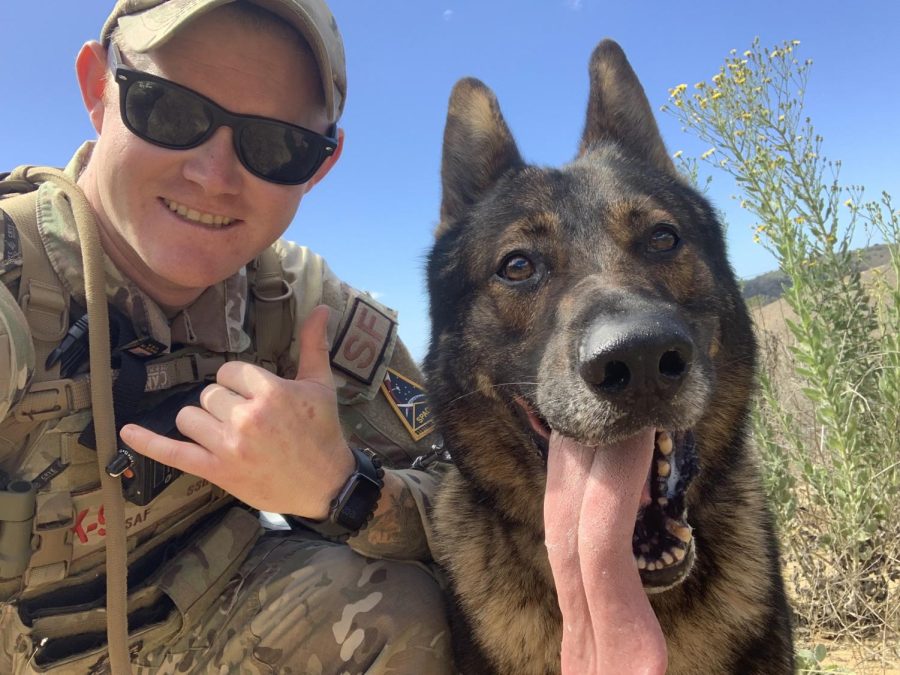Fentanyl: Intended Use, Abuse, and Affects
A certain synthetic opioid, called fentanyl, is altering the way citizens and workers live, all over the country.
Fentanyl affects more than just humans. Military officer and K9 bond is like none other. Connor Washburn poses with K9 Unit ‘Boy’, while in training, on duty. Connor Washburn, (28 M), is stationed in California. Boy, the K9, and Washburn make a great team together. “This one is boy. The most recent dog I had assigned to me earlier this year.” Washburn and other K9 handlers are not only assigned to one K9 unit. They must adapt and work with every dog individually to achieve success. Not only can fentanyl affect humans, but Washburn says it has also made K9 searches very difficult, because the K9 can overdose very easily. Washburn explained that in order to protect the K9, Narcan is used because it “counteracts the effects of fentanyl, and so for the dog… it is something we can put in front of their nose, so they can smell it.” Military working dogs are able to inhale Narcan where as, as stated by Washburn, “… for us, it’s a shot, very similar to an epi-pen.”
November 28, 2022
Fentanyl Is a synthetic opioid. These are substances that are synthesized in a laboratory and act on the same targets as natural opioids. This synthetic opioid, traditionally used in pharmaceuticals, is professionally distributed for pain relief. Many people who take Fentanyl do so in the form of medication. This drug is a pain killer, the strongest one, which is 50 times stronger than heroin, and 100 times stronger than morphine.
Like any drug, fentanyl can be abused. Many people who overdose on Fentanyl have what is called ‘wooden chest syndrome’ or ‘Fentanyl Death Pose’. After overdosing on Fentanyl, the body will stiffen. Every day, over 150 people die due to synthetic opioids like fentanyl. With only 2 salt sized grains of fentanyl, any person is at risk of overdosing.
Fentanyl reacts with the body in powerful ways. Everything, especially the addictive parts of fentanyl, all have to do with the human body’s naturally occurring chemicals.
There are four main chemicals which contribute to the feeling and addictions that come along with fentanyl. These are Endorphins, Dopamine, Serotonin, and Oxytocin. The chemical which naturally releases in the human body called Oxytocin, gives people the feeling of love, trust, or relaxation. Oxytocin is a chemical which cannot be released without a cause, unlike Endorphins. Endorphins are a chemical product human bodies can naturally produce, but on their own, without other people causing them to be released. Endorphins are the chemicals that mask physical pain. Though this attempt to mask physical pain, eventually, will wear off. This is why, when used responsibly, fentanyl is given by doctors to patients in chronic pain.
Another bodily chemical, called dopamine, takes part in the need/ addictions of fentanyl. Dopamine is the chemical that is responsible for addictive traits. Dopamine is the chemical that makes us feel accomplished. Many people’s bodies release this chemical when crossing out an item on a to-do list, while others release this chemical when they fulfill a craving or addiction that they have.
Fentanyl is an addictive substance because of the bodily chemicals that it releases. After the endorphins throughout the body release and cortisol is flowing, dopamine is released which ‘cancels out’ the cortisol and allows oxytocin to be released. People are addicted to the release of oxytocin, and assume it happens because of what they do. Chemical releases throughout the body do not rely on exterior factors, the body will release these chemicals regardless of what someone does.
At Natrona County High School (NCHS), resource officer Charley Simmons also has significant insight on the increasing prevalence and deadly effects on fentanyl. Simmons says, “Yes, yeah its {Fentanyl} become more prevalent…” Simmons explains that over the past one and a half years especially, fentanyl has become a significantly more ‘popular’ drug.
When the question arises, will this negatively affect my community, Simmons replies, “It can, just because you know, it kills so many people… so yes, it can be pretty detrimental, and kill people that don’t know they are doing that, {taking fentanyl}, or killing family members, or through accidental overdoses and things like that.”
Simons shares that in Casper, there isn’t an overwhelming population of people addicted to fentanyl in particular, but that in his four on and off years of working within the school district, he has dealt with his share of drug users.
Although expected, Simmons’s advice is raw and directed to the teenagers here at NCHS.
“Don’t do drugs.”

